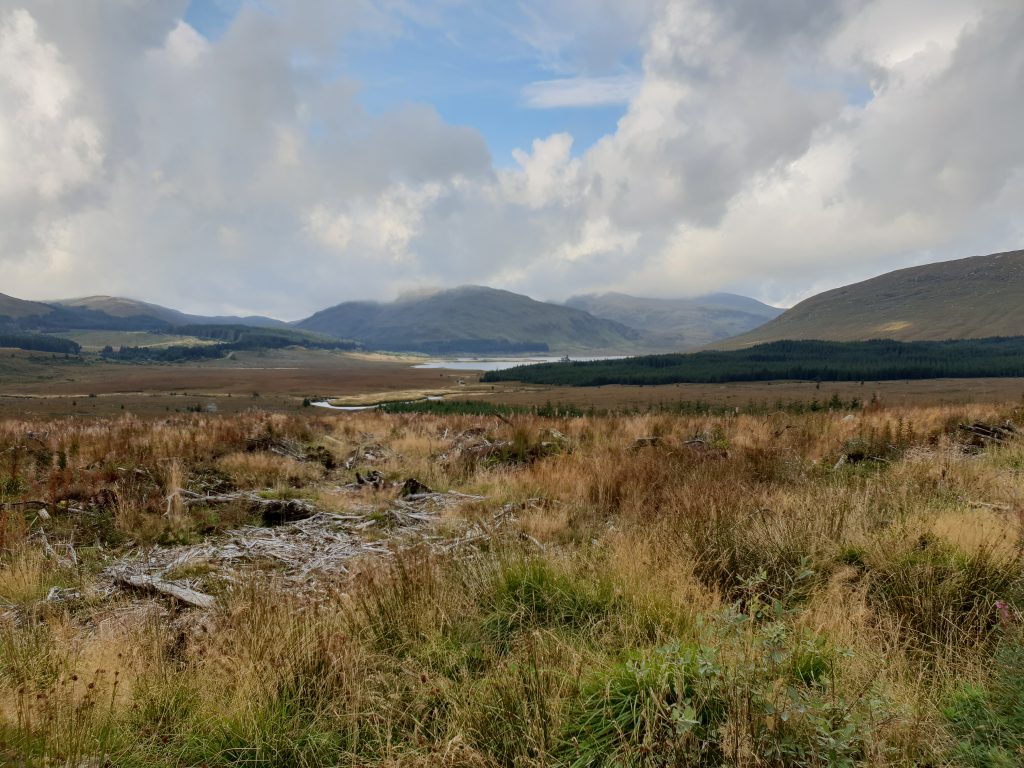Exploring Silver Flowe
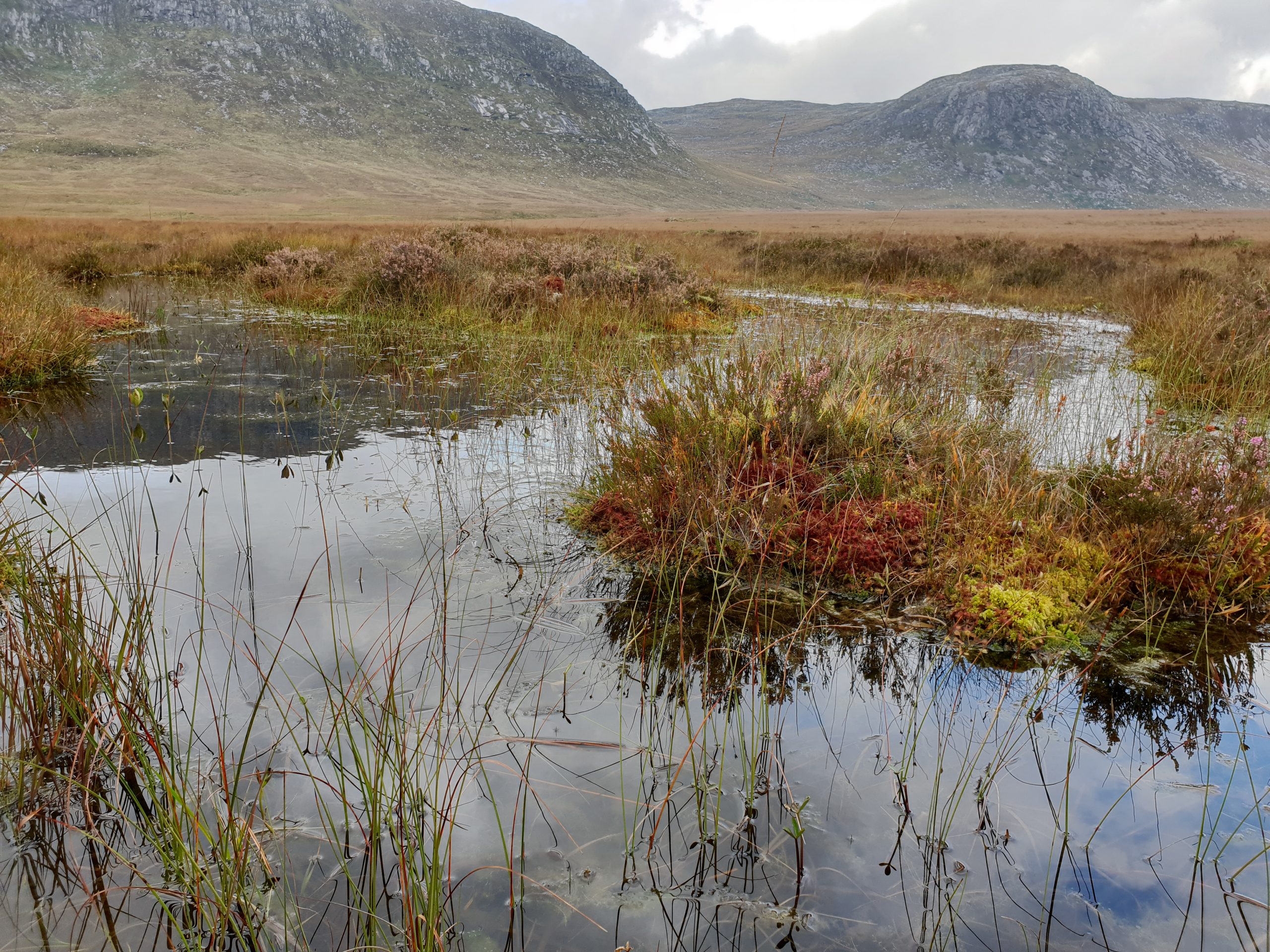
This is the last in a trilogy produced by our Project Support Officers Jake and Malcolm who went out exploring the Core Areas of our UNESCO Biosphere before the more inclement weather of autumn set in.
Silver Flowe is the most important, varied, and least disturbed system of patterned blanket bog in Britain, and the most extensive unafforested upland area in Galloway. It is an essential part of our UNESCO Biosphere designation; indeed, the designation developed from recognition of Silver Flowe as a RAMSAR site (wetland of international importance) and SSSI.
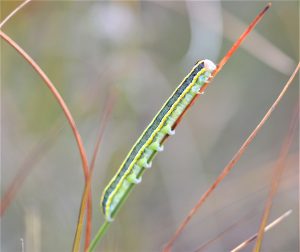 There are many parts of the GSA Biosphere which are not easily accessible and which we would not recommend for casual adventures, either because the landscape is challenging to move across or because conservation is so critical that wildlife and habitats should not be disturbed. Silver Flowe is one such place, and this visit was mapped, planned and led by senior members of our team. Not uncommon in the UK but incredibly beautiful is the caterpillar of the Broom Moth (Ceramica pisi), pictured right, photographed by Malcolm on this trip – we hope you enjoy more of his photos in this feature.
There are many parts of the GSA Biosphere which are not easily accessible and which we would not recommend for casual adventures, either because the landscape is challenging to move across or because conservation is so critical that wildlife and habitats should not be disturbed. Silver Flowe is one such place, and this visit was mapped, planned and led by senior members of our team. Not uncommon in the UK but incredibly beautiful is the caterpillar of the Broom Moth (Ceramica pisi), pictured right, photographed by Malcolm on this trip – we hope you enjoy more of his photos in this feature.
We have encouraged Jake and Malcolm to share their personal experiences of each site they visit, to demonstrate the variety and value in finding our own individual connections with nature – not every outing is easy, and not every emotion that nature inspires is comfortable to feel! If you have experienced Silver Flowe or indeed any other of the many special locations in the GSA Biosphere and would like to share your thoughts, please do get in touch with any member of our team via info@gsabiosphere.org.uk.
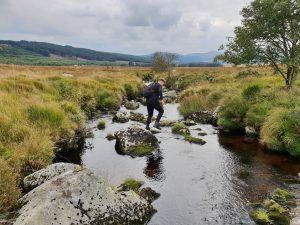 Jake: Silver Flowe was a unique visit and much different from the two other Core Areas. To reach this special area required a trip along a narrow single-track road followed by rough forest road and then a walk. This truly remote area appears as an unassuming field from a distance, but this assumption is quickly shattered once you step further.
Jake: Silver Flowe was a unique visit and much different from the two other Core Areas. To reach this special area required a trip along a narrow single-track road followed by rough forest road and then a walk. This truly remote area appears as an unassuming field from a distance, but this assumption is quickly shattered once you step further.
To enter the area, we were forced to cross a large burn (pictured left). Luckily, we had a few stepping stones to assist in this. we were then greeted by the bog which was difficult to traverse leading to us bobbing and weaving through bog pools.
The cliffs on the banks of the glen were sharp cut outs of rocks that glistened in the sunlight, and we were convinced at the time this was where the name Silver Flowe may have come from as the rocks appeared a pure silver.
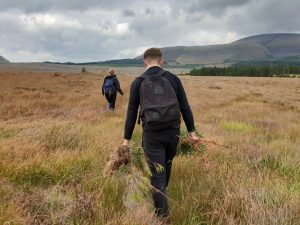 While in the middle of this bog we passed some small spruce saplings growing which we decided to do our duty to the bog and remove them (pictured right) as these take in water from the surrounding areas and damage the bog system.
While in the middle of this bog we passed some small spruce saplings growing which we decided to do our duty to the bog and remove them (pictured right) as these take in water from the surrounding areas and damage the bog system.
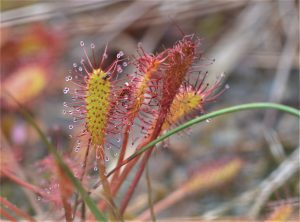 In the middle of our excursion, we came across an area which had a truly amazing bog pool system. it sported all sorts of plant life in it and surrounding it. As this is within the Core Area of the biosphere our logo the roundleaf sundew made plenty of appearances, but so did a rarer spot the great sundew (pictured left) which was an exciting find.
In the middle of our excursion, we came across an area which had a truly amazing bog pool system. it sported all sorts of plant life in it and surrounding it. As this is within the Core Area of the biosphere our logo the roundleaf sundew made plenty of appearances, but so did a rarer spot the great sundew (pictured left) which was an exciting find.
This area is truly spectacular and was certainly one of the most unique places I’ve seen. As we attempted to leave, we were met with treacherous conditions, the land had pits which caused trips and falls but we braved on and managed to escape the Silver Flowe unharmed.
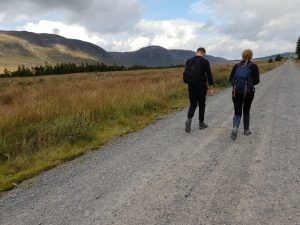 Malcolm: Grey stane forest tracks cleaved the wooded and boggy landscape. Sturdy and defiant they led our way towards Silver Flowe. The sitka forest that once stood had fallen. Laid low by mechanical monstrosities, rendering a scarred and weeping landscape. The peaty drains running like tears. Yet in its mourning, a single pied wagtail foraged – perhaps the wild things had returned to live in this landscape once again? A flicker of hope amongst the desolation.
Malcolm: Grey stane forest tracks cleaved the wooded and boggy landscape. Sturdy and defiant they led our way towards Silver Flowe. The sitka forest that once stood had fallen. Laid low by mechanical monstrosities, rendering a scarred and weeping landscape. The peaty drains running like tears. Yet in its mourning, a single pied wagtail foraged – perhaps the wild things had returned to live in this landscape once again? A flicker of hope amongst the desolation.
We soon abandoned our road for a more treacherous path. Tales had been told of many a wanderer lost in the boggy pools of Silver Flowe. Who could tell what fell things lay in the dank recesses of the mire? The bog is disguised from afar as a small field but once traversed its vastness and wetness revealed. For the bog is a deceiver, the grasses and moss feign paths that do not exist. We trod with tireless caution, determined to avoid a harrowing fate.
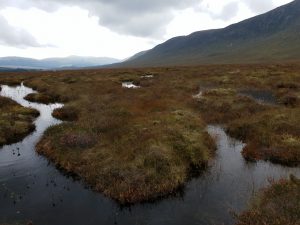 The closer we got to the bog the more of its ancient beauty was uncovered. Sphagnum in hues of red, orange and green added a kaleidoscope of colour to the otherwise drab landscape. The black water decorated with bog beans shimmered in the soft breeze – a dark draw we knew to resist.
The closer we got to the bog the more of its ancient beauty was uncovered. Sphagnum in hues of red, orange and green added a kaleidoscope of colour to the otherwise drab landscape. The black water decorated with bog beans shimmered in the soft breeze – a dark draw we knew to resist.
In my mind plants are pure, as sign of life. Yet here they dealt in death. Greater and round leaved sundews abounded, sirens of the mire, adorned with jewels of dew, luring insects with the promise of sweet nectar only to drown their admirers with the very treasure they seek. Their sticky leaves coil around each victim like a serpent, consuming any nourishment to be found.
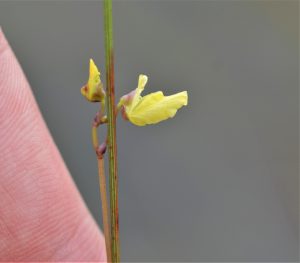 Even in the water, the same sense of being forsaken. Lesser bladderwort (pictured right) are jailers, covered in hundreds of traps that once entered can never be escaped – they close in less than a millisecond and seal with a grip of iron. Its diet is insatiable and even tadpoles fall prey to this weed which is a fate worse than death; too large to fit into a single trap, a tadpole will be only partly digested and left unable to escape.
Even in the water, the same sense of being forsaken. Lesser bladderwort (pictured right) are jailers, covered in hundreds of traps that once entered can never be escaped – they close in less than a millisecond and seal with a grip of iron. Its diet is insatiable and even tadpoles fall prey to this weed which is a fate worse than death; too large to fit into a single trap, a tadpole will be only partly digested and left unable to escape.
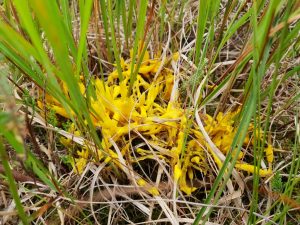 At the base of several grasses was revealed a strange yellow ooze, as bright as citron and as viscous as custard. The yellow goo was in fact a colony of slime mould, single-celled organisms that feed on rotting matter. This alien substance is as mythical as it appeared, its whole lifespan comes and goes in days, attracted only briefly by the dreich, damp and decay of the blanket bog.
At the base of several grasses was revealed a strange yellow ooze, as bright as citron and as viscous as custard. The yellow goo was in fact a colony of slime mould, single-celled organisms that feed on rotting matter. This alien substance is as mythical as it appeared, its whole lifespan comes and goes in days, attracted only briefly by the dreich, damp and decay of the blanket bog.
As our journey drew to a close, we ambled down the rocks of Cooran Lane, a burn dyed black by the peaty soil. The gentle whispers of the stream soothed our souls from the dark secrets the bog had revealed. I’d warn anyone not to wander this strange and treacherous land.
If you haven’t already please do take a look back at Jake and Malcolm’s visits to Cairnsmore of Fleet and Merrick Kells, also Core Areas of the GSA Biosphere and which have their own special sense of place. For more information about wetland areas, land use and biodiversity in our region please do get in touch with our Land Use Advice Officer, Mary Berry, via mary@gsabiosphere.org.uk.
Our final photo below shows the view from Silver Flowe.
